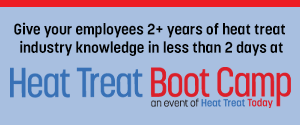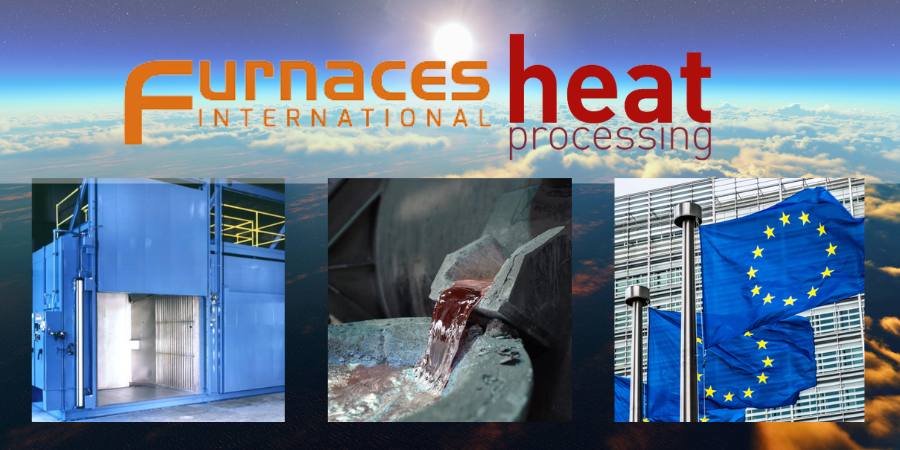In this informative piece, professional recruiters in the heat treat industry answer questions about what to expect in the heat treat industry’s hiring environment, with valuable insight both for hiring companies and rising talent.
Josh Hale, managing recruiter, and Jessica Maier, senior recruiter, both of International Search Partners, discuss changes in the hiring landscape within the heat treat industry. Their topics include adaptability to industrial technology innovations, Gen Z expectations and how hiring personnel can best articulate their needs to this labor group, and the most in-demand skill that industry employers will be looking for in 2025.
This article was first released in Heat Treat Today’s January 2025 Technologies To Watch in Heat Treating print edition.
Q1: In 2020–2021, placing long term employees became a difficult challenge to solve. As we approach the end of 2024, how has the hiring scene changed?
Josh Hale (JH): In many ways it hasn’t; it continues to be a candidate-driven market that’s tight on talent and robust in openings, and it’s hard to see things changing any time soon. With more established professionals entering retirement, fewer new workers coming in from the younger generations to meet replacement needs, and overall growth in the industry, there very simply remains a huge demand for workers and a dearth of supply.
Q2: The nature of work continues to evolve rapidly. From robotics and AI to various GPTs tailored for specific company use, industrial technology innovations continue to alter the workplace. For an industry that historically has been slow to change, have we seen any changes in how heat treat employers look to fill labor needs, compensate employees, etc.?
JH: It’s taken some time, but finally, YES! The heat treat industry isn’t known to be the bastion of new technology and has a reputation for being slow to change, but we’re just now starting to see some developments, including very simple things like touch screens, updated computers, etc. to bigger, more cultural shifts, like flexible schedules and remote work options (where applicable). At FNA in October, there were even a few furnace OEMs sharing new artificial intelligence products! This is all great news, especially for a historically very traditional industry that has been slow to evolve. Progress, growth, and getting up to speed with 21st century systems, tools, and norms goes a long way towards attracting younger talent.

Q3: What strategies have heat treat departments or companies been using to find, hire and retain the “best fit” job hires? What makes them successful (or not successful at all)?
JH: The best way for a company to hire top talent is to engage the services of a professional recruiter. I might be biased, but there’s a good reason for this — in a tight labor market where unemployment is at record lows, the best employees are currently working and engaged in their jobs and being treated very well by their employers. High performers aren’t trolling job boards, applying online, or sending out résumés. An experienced recruiter can reach this untapped market of passive candidates by reaching out to currently employed individuals and enticing them to other opportunities — I call this “surgical recruiting” because it is quite simply “cutting” an employee out of one company and placing them in another.
I also like using sports as an analogy. Imagine that you want to put together the best baseball team in the world. Are you going to post an ad online and hope Shohei Ohtani applies, or are you going to pursue him and try and lure him to quit the Dodgers and join your team? That’s the difference between direct recruiting vs. “post and pray” (the nickname recruiters give to advertising jobs online and hoping for the best), and the service that a good third-party recruiter provides.
Q4: When it comes to young people (particularly Gen Z), they have grown up in a different age of the internet and have certain expectations about what starting a career looks like, such as: How or when career mile markers are accomplished, the purpose of work, the nature of how work is accomplished, and what job benefits should look like. Translated to the heat treat industry, are there any expectations that you would encourage Gen Z to maintain, and why? Alternatively, are there certain misconceptions that you would want to reframe for them so they have a better idea of what to look for in their job options?
Jessica Maier (JM): I’m closer to this generation than Josh (Gen X), but I’m still a Millennial. I have also studied the topic and talked to many in the Gen Z workforce and gotten a good sense of their expectations. From my research, early career Gen Zs are looking for the following (along with my commentary as it pertains to the heat treat industry):
1. GEN Z EXPECTATION: 2–3 year mile markers (target and goals accompanied by either promotion or raises)
HEAT TREAT TRANSLATION: One thing that we’re seeing with the younger generation is that company loyalty is becoming less valued. If Gen Z workers don’t see the mile markers that they’re looking for in those first few years, their eyes will start to wander. While a promotion might not always be viable for someone working in a small commercial heat treat company, raises combined with praise go a long way and are achievable for most managers.
2. GEN Z EXPECTATION: A strong sense of purpose in their work (i.e., they want to feel fulfilled in their work and not feel like they’re just punching a clock)
HEAT TREAT TRANSLATION: Heat treating has a huge impact on the world, but that contribution can sometimes get lost in the shuffle of everyday work. An initiative to highlight these impacts could go a long way. Additionally, we often hear from younger candidates, “I don’t want to feel like a number; I want to feel like a human being.” Managers making a point to make sure their employees feel seen and heard could also be a quick and easy (and free!) feel good fix in this regard.
3. GEN Z EXPECTATION: PTO around 15–20 days to start, not including holidays along with basic benefits (medical/vision/401k)
HEAT TREAT TRANSLATION: Gen Z would do well to adjust these expectations a bit. I have rarely seen an entry-level position begin with more than 2 weeks (10 days) PTO. This is the norm for the first year of employment with opportunities to gain more in the future. Other benefits (health insurance, etc.) are usually standard across the board for most companies. As Gen Zs are younger and typically single, they are not usually looking at benefits for families but focused on individual care. In general, however, the more that is paid by the company, the more appealing it is for the worker (which can be a useful recruitment and/or retention tool).
Note about 401ks … Gen Z is learning from previous generation’s mistakes and are very interested in getting a jump on their retirement funds. With that, and in the same vein as the benefits, the higher the percentage matched by the company, the more appealing it is to the employee — another great tool for attracting top talent!

4. GEN Z EXPECTATION: Work/life balance (including the WFH trend kicked off by the pandemic)
HEAT TREAT TRANSLATION: In a post-COVID world, “work/life balance” is a huge buzz word in the hiring process, and with that, I see some good news and bad news as it pertains to the heat treating industry … the good news for Gen Z is that we’re seeing a trend of companies understanding that when an employee is not “on the clock,” they are not expected to be attached to their phones or emails and provide an immediate response. The bad news for Gen Z is that being on site is critical for many/most of the jobs in the industry. Of course, there are exceptions (hello, Sales!), but generally, it remains true that remote work is untenable for most heat treaters.
5. GEN Z EXPECTATION: Fair pay
HEAT TREAT TRANSLATION: We could talk about this for hours, but I’ll boil it down to this: If you’re a younger Gen Z who is looking for a job, you’re likely not going to get the pay that your professor, buddy, or family member told you to aim for … on the flipside, if you’re a manager looking to hire, you’re probably going to pay a little more for entry-level talent than you probably thought. Expectations need to be adjusted on both sides.
Q5: What is the number one mistake entry-level engineers in heat treat make when applying for jobs?
JM: This sounds crazy but the number one mistake is not applying! I can’t tell you how many times we talk to talented engineers that see a job description and decide that they are not right for a role because they don’t have one or two of the bullet points listed. You need to take job descriptions with a grain of salt. Generally, the description is a list of what an employee will be doing once they’ve earned the role, but what many people forget is that you can (and will) learn skills on the job. Speaking to employers now — if you want superstar entry-level engineers to eventually take the place of your veterans that are nearing (well deserved!) retirement, invest in heat treat education for the younger generation!
It’s taken some time, but finally, YES! The heat treat industry isn’t known to be the bastion of new technology and has a reputation for being slow to change, but we’re just now starting to see some developments, including very simple things like touch screens, updated computers, etc. to bigger, more cultural shifts, like flexible schedules and remote work options (where applicable).
Josh Hale
Q6: In 2025, what will be the most in-demand skill that industry employers will be looking for? What can job seekers do to position themselves best for this position?
JM: Field service and maintenance. Next question.
JH: Okay, I’ll handle this one … Jessica isn’t joking. FSEs and maintenance professionals of all levels are hyper in demand across the board. If you can spell “PLC” and have seen a furnace, we probably have a job for you! To get more to the heart of your question, however, we are seeing companies seeking more communication skills. Gone are the days of engineers sitting behind a desk and programming all day from their cubicle. Today’s technical roles often involve customer interaction, sales support, and a level of interdisciplinary collaboration that requires interpersonal skills, verbal communication abilities, and competency in writing. Often, we see the “C” student who maybe partied a little too hard in college but learned to socialize get hired over the “A+” candidate who can’t string a coherent sentence together while making eye contact. A lot of this might sound like stereotypes, but it is true. I recommend students in engineering and materials science to take some humanities or writing courses in college to help and that more established workers should consider toastmasters or improv classes to better position themselves to be competitive in the future.
Q7: 10 years from now, what can we expect to change in job openings, availability, and work-life balance in the heat treat industry?
JM: I wish I had a crystal ball to tell you the exact future, but seeing as I’m only human, here are my best guesses:
- Job openings: As someone who has spent almost a decade working in the heat treat world, I can safely say that most of the job openings will remain the same. Roles like field service engineer, sales, metallurgist, design engineer, etc. will always be in demand. However, I think we will start to see more technology incorporated into these roles. At the most recent FNA show in October, we saw many companies bringing new and better software into the mix. Not only will current positions start to involve more tech, but I think we will see some newer positions, like software engineers, join the industry as well.
- Availability: As mentioned, a lot of experienced heat treat professionals are starting to reach retirement age, while some are working well into their 60s and beyond, I think we’re going to hit a point in the next 10 years where that dam will break, and we’ll see a large wave of retirement which will open up A LOT of previously tenured positions.
- Work-life balance: For Gen Z, work-life balance is of high priority. For heat treat companies to compete, they need to be willing to give more consideration to remote work where applicable and offer flex schedules when possible. Of course, many of the roles we come across in the heat treat industry would not do well remote as they are either hands-on or collaborative. That said, for an on site employee, 40–50 hours should be considered the norm. With many heat treaters operating 24/7, companies may need to come to terms with the need to hire more people or dole out extra incentives, such as bonuses or overtime to keep their workforce engaged.
About the Authors:

Jessica Maier, Senior Recruiter, International Search Partners (right)
Josh Hale has collaborated with companies to identify, engage, and hire top performers as a professional “headhunter” where he’s focused exclusively on the heat treat industry as part of International Search Partners since acquiring the firm in 2015.
Jessica Maier works closely with him to support the practice, and, together, they’ve helped dozens of companies and hundreds of candidates find a match within the industry, including roles for engineering, sales, quality, metallurgy, management, and more.
For more information: Contact Josh and Jessica at info@internationalsearchpartners.net or call 619-465-9621.







